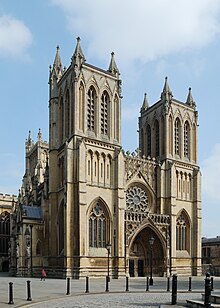
Back Seu de Bristón AN كاتدرائية برستل Arabic Брыстальскі сабор Byelorussian Catedral de Bristol Catalan Bristolská katedrála Czech Bristol Domkirke Danish Kathedrale von Bristol German Katedralo de Bristolo Esperanto Catedral de Brístol Spanish Bristolgo katedrala Basque
| Bristol Cathedral | |
|---|---|
| Cathedral Church of the Holy and Undivided Trinity | |
 The west front of Bristol Cathedral | |
| 51°27′06″N 2°36′03″W / 51.4517°N 2.6007°W | |
| Location | Bristol |
| Country | England |
| Denomination | Church of England |
| Previous denomination | Catholic Church |
| Churchmanship | Central/High church |
| Website | bristol-cathedral.co.uk |
| History | |
| Consecrated | 11 April 1148 |
| Architecture | |
| Heritage designation | Grade I listed building |
| Designated | 8 January 1959 |
| Style | Norman, Gothic, Gothic Revival |
| Years built | 1220–1877 |
| Specifications | |
| Length | 300 feet (91 m)[1] |
| Nave length | 125 feet (38 m)[1] |
| Width across transepts | 29 feet (8.8 m)[1] |
| Nave height | 52 feet (16 m)[1] |
| Choir height | 50 feet (15 m)[1] |
| Administration | |
| Province | Canterbury |
| Diocese | Worcester (until 1541) Gloucester (1541–43) Bristol (1543–1836) Gloucester and Bristol (1836–1897) Bristol (1897–present) |
| Clergy | |
| Bishop(s) | Vivienne Faull |
| Dean | Mandy Ford |
| Canon(s) | Nicola Stanley
(Canon Pastor) Martin Gainsborough (Bishop's Chaplain and Diocesan Canon) Jonnie Parkin (Canon Missioner) |
| Curate(s) | Nic Harris |
| Laity | |
| Director of music | Mark Lee (Master of the Choristers & organist) |
| Organist(s) | Paul Walton (assistant organist) |
Bristol Cathedral, formally the Cathedral Church of the Holy and Undivided Trinity, is a Church of England cathedral in the city of Bristol, England. It is the seat of the Bishop of Bristol. The cathedral was originally an abbey dedicated to St Augustine, founded in 1140 and consecrated in 1148.[2] It became the cathedral of the new diocese of Bristol in 1542, after the dissolution of the monasteries. It is a Grade I listed building.[1]
The earliest surviving fabric is the late 12th century chapter house, which contains some of the first uses of pointed arches in England. The eastern end of the church is medieval, the oldest part being the early 13th century elder lady chapel. The remainder of the east end was rebuilt in the English Decorated Gothic style during the 14th century as a hall church, with aisles the same height as the central choir. In the 15th century the transepts were rebuilt and the central tower added. The nave was incomplete when the abbey was dissolved in 1539 and demolished; a Gothic Revival replacement was constructed in the 19th century by George Edmund Street, partially to the original plans. The western towers, designed by John Loughborough Pearson, were completed in 1888.
In addition to the cathedral's architectural features, it contains several memorials and an historic organ. Little of the original stained glass remains, with some being replaced in the Victorian era and further losses during the Bristol Blitz.
- ^ a b c d e f Historic England. "Cathedral Church of St Augustine, including Chapter House and cloisters (1202129)". National Heritage List for England. Retrieved 3 April 2015.
- ^ Smith 1970, p. 6.
